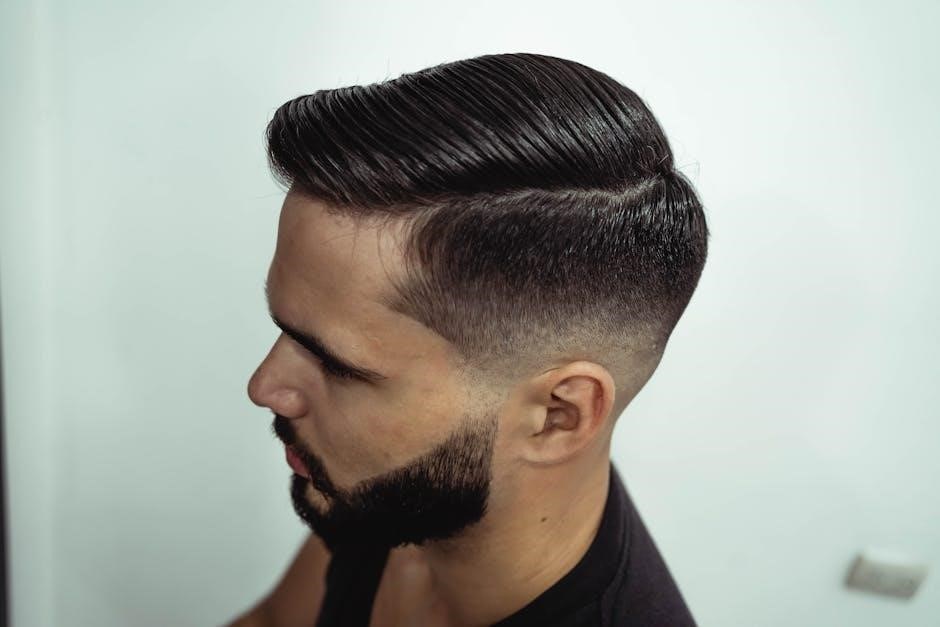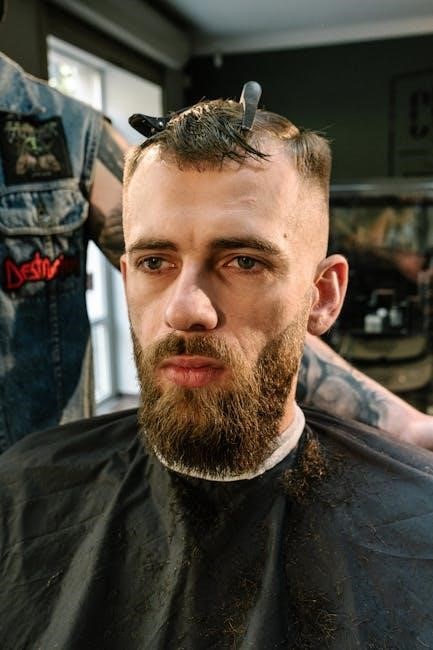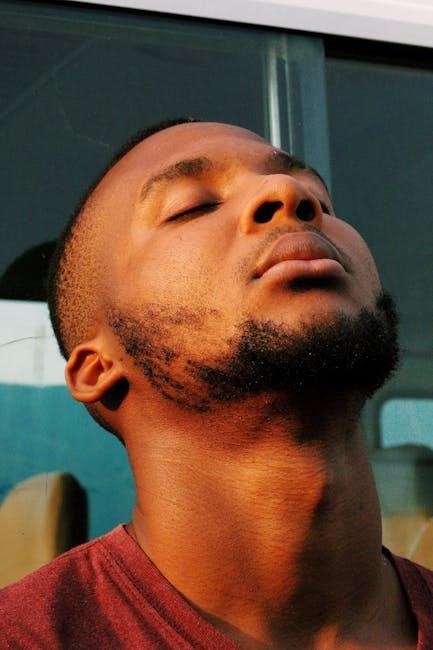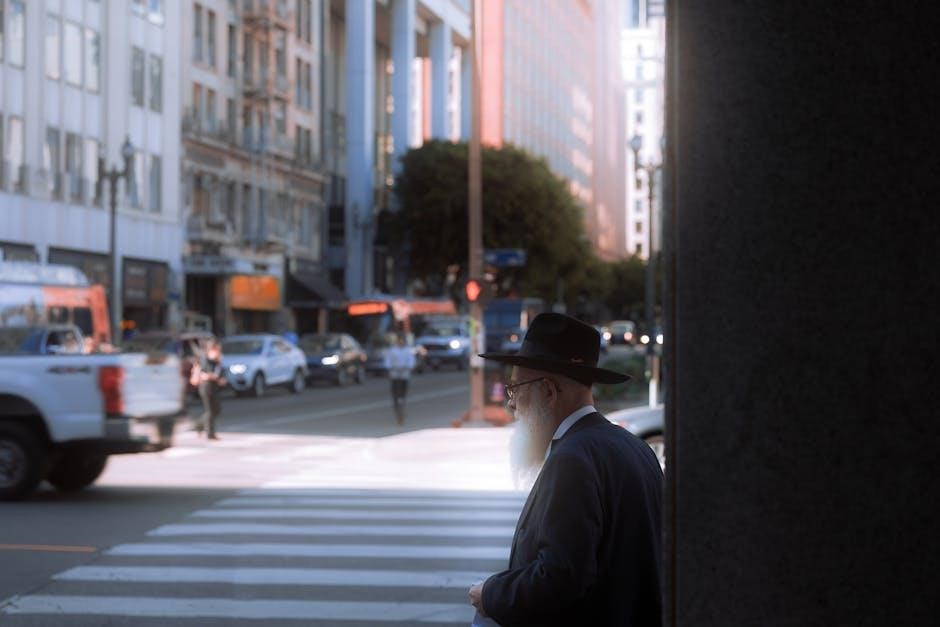A beard fade is a modern, sleek grooming technique that blends facial hair seamlessly, creating a polished look. It enhances facial features and suits various styles and face shapes.
What is a Beard Fade?
A beard fade is a grooming technique where facial hair transitions smoothly from shorter to longer lengths, creating a seamless, polished look; It involves blending the beard hair with the skin or shaved areas, typically around the cheeks, jawline, and neck. This style can be tailored to suit various face shapes and beard lengths, offering a modern, clean aesthetic. The fade effect can be subtle or dramatic, depending on personal preference. It enhances jawline definition and pairs well with different hairstyles, making it a versatile choice for men seeking a stylish, put-together appearance. Whether you prefer a high, mid, or low fade, this technique adds precision and sophistication to your beard style.
Why Choose a Beard Fade?
A beard fade is a popular choice for men seeking a modern, polished look that enhances their facial features. It offers versatility, suiting various face shapes, beard lengths, and personal styles. The fade creates a seamless transition between beard hair and shaved areas, providing a clean, sophisticated appearance. This style is ideal for those who want to add definition to their jawline or balance their facial structure. Additionally, a beard fade is low-maintenance compared to traditional beard styles, as it requires regular trimming to maintain the blended effect. It’s also a great option for men with patchy beards, as it creates a fuller, more even look. Whether you’re aiming for a subtle, natural fade or a bold, dramatic contrast, this style is a timeless choice for a sleek, contemporary aesthetic.
Understanding Different Types of Beard Fades
Beard fades come in high, mid, and low variations, each offering unique styling options to complement different face shapes and personal preferences, ensuring a customized look.
High Fade Beard
A high fade beard features a sharp, defined transition near the temples, blending facial hair seamlessly into the skin or shaved areas. This style emphasizes facial structure and offers a clean, modern aesthetic, ideal for those with angular features. It pairs well with short hairstyles and is popular among men seeking a bold yet sophisticated look. The high fade beard is a versatile choice, suitable for both casual and formal settings.
Mid Fade Beard
A mid fade beard offers a balanced transition, starting midway up the cheeks and blending into the beard. It creates a subtle contrast, making it ideal for men with round or oval face shapes. This style is versatile, complementing both casual and professional looks while maintaining a natural appearance. The mid fade beard is perfect for those who want a stylish yet understated groomed look, as it softens harsh features and enhances facial symmetry. It allows for personalization, making it a popular choice among men seeking versatility in their grooming routine.
Low Fade Beard
A low fade beard is a subtle and versatile style that begins near the jawline, blending the beard seamlessly into the skin. This technique creates a natural, clean look without harsh lines, making it suitable for various face shapes and beard lengths. The low fade is ideal for men who prefer a discreet transition, as it enhances facial symmetry while maintaining a soft, polished appearance. It works well with both short and long beards, offering a timeless appeal. Regular maintenance is key to keeping the fade defined, ensuring the style remains sharp and sophisticated. This approach is perfect for those seeking a low-maintenance yet stylish groomed look that complements their overall aesthetic.

Preparation for a Beard Fade
Preparation involves growing your beard to the desired length and choosing a style that complements your face shape, ensuring a smooth transition for the fade technique.
Growing Your Beard
Growing your beard is the first step in achieving a perfect fade. Allow your beard to grow for several weeks to ensure adequate length for blending. Use beard oils to keep it healthy and shiny, promoting even growth. Avoid trimming too early, as sufficient hair is needed for the fade technique. Be patient, as consistent growth is key to a seamless transition.
Choosing the Right Style
Selecting the right beard fade style involves considering face shape, beard length, and personal preference. For oval faces, a mid or high fade works well, while round faces benefit from a low fade to elongate the jawline. Square faces look best with soft, natural transitions. Choose between high, mid, or low fades based on how much contrast you desire. If unsure, consult a barber to determine the most flattering style for your features and lifestyle. This step ensures your fade complements your overall appearance and maintains a polished, modern look.

Tools and Products Needed
Essential tools include trimmers, clippers, and beard fade kits. Use oils and balms for maintenance and a neat finish.
Trimmers and Clippers
Trimmers and clippers are indispensable for achieving a precise beard fade. They allow for clean lines and gradual transitions in hair length. Use adjustable clippers for consistency and sharp trimmers for detailing around the edges. Regular maintenance with these tools ensures a polished look and prevents uneven growth. Properly maintained equipment is essential for the best results.
Beard Fade Kits
Beard fade kits simplify the process, offering all necessary tools for a professional finish. These kits typically include adjustable clippers, precision trimmers, and guide combs, ensuring a seamless transition between lengths. They cater to both novices and experienced users, providing consistency and ease in achieving the desired style. Using a fade kit helps maintain a polished look and enhances overall grooming effectiveness, making it a valuable addition to any beard care routine.

Step-by-Step Guide to Achieving a Beard Fade
Section your beard, trim evenly, and blend for a seamless transition. Use clippers and trimmers to achieve precision, ensuring a smooth, professional-looking fade from start to finish.
Sectioning Your Beard
Sectioning your beard is the first step in achieving a precise fade. Start by dividing your beard into manageable parts, typically by separating the cheek and chin areas. Use clips to keep the top section away from the jawline, allowing you to focus on blending the lower part smoothly. This method ensures even trimming and prevents uneven lines. By clearly defining each section, you can work methodically, maintaining control and accuracy. Proper sectioning sets the foundation for a seamless fade, making the process easier and the results more professional.
Trimming Techniques
Mastering trimming techniques is crucial for achieving a professional-looking beard fade. Start by using clippers with adjustable guard sizes, beginning with a lower guard for shorter areas near the temples and jawline. Gradually switch to higher guards as you work toward the thicker parts of your beard to create a seamless blend. Always trim in the direction of hair growth to avoid unevenness and ingrown hairs. Use light, steady strokes, keeping the clippers flat against your skin for precision. Pay special attention to the neckline and cheekbones, ensuring smooth transitions. For finer details, switch to a trimmer without a guard to clean up stray hairs and refine edges. Regular practice and patience are key to perfecting these techniques, resulting in a polished, professional fade.
Blending for a Natural Look
Blending is essential for achieving a natural-looking beard fade. Start by identifying the transition point where the fade begins, typically along the jawline or temples. Use clippers without a guard to create a subtle gradient, feathering the hair to ensure a smooth transition. For a seamless blend, work in small sections, gradually decreasing the length as you move toward the fade area. Lightly overlap strokes to merge shorter and longer hairs, avoiding harsh lines. Finish by tidying stray hairs with a trimmer and applying a beard oil for a polished finish. This technique ensures your fade appears effortless and natural, enhancing your overall style without looking overly done.
Maintenance and Upkeep
Regular trimming and grooming are key to maintaining a beard fade. Use clippers weekly to keep the fade defined and prevent uneven growth for a sharp, polished look.
Regular Trimming
Regular trimming is essential to maintain the clean, defined look of a beard fade. Use clippers weekly to keep the sides and neckline sharp and prevent stray hairs. Start with a lower guard size near the temples and blend upwards, ensuring a seamless transition. Trimming also helps maintain the desired length and shape, keeping the beard looking neat and polished. For best results, trim every 2-3 days to stay ahead of hair growth. This consistent upkeep prevents the fade from becoming uneven and keeps the style fresh. Over time, regular trimming becomes second nature, making it easy to preserve your beard fade’s sophisticated appearance.
Using Beard Products
Using high-quality beard products is crucial for maintaining a healthy, well-groomed beard fade. Beard oil and balm are essential for softening facial hair and keeping the skin underneath moisturized, reducing itchiness and dandruff; Regular application ensures the beard remains shiny and manageable, complementing the fade’s clean look. Additionally, using a beard wax or styling balm can help shape and define the beard, especially around the jawline and edges. Trimming products like clippers and precision trimmers are vital for touch-ups and maintaining the fade’s sharp lines. Incorporating these products into your daily routine enhances the overall appearance and longevity of your beard fade, ensuring it stays polished and professional.
Common Mistakes to Avoid
Avoid uneven blending and incorrect guard sizes when creating a beard fade. These mistakes can lead to patchy transitions and an unpolished finish, ruining the desired seamless look.
Uneven Blending
Uneven blending is a common mistake that disrupts the smooth transition of a beard fade. It occurs when the hair lengths and textures don’t merge seamlessly, creating visible lines or patches. To avoid this, use a trimmer without attachments for precise control and blend gradually, starting from the shortest area. Regularly check your progress in a mirror to ensure consistency. Applying too much pressure or moving the trimmer too quickly can also cause unevenness. Patience and careful technique are key to achieving a natural, flawless fade. Proper blending enhances the overall aesthetic, making it essential to master this step for a professional-looking beard fade.
Incorrect Guard Sizes
Using the wrong guard size is a frequent error that can ruin a beard fade. Guards that are too small may cut the hair too short, creating an abrupt transition, while guards that are too large can leave uneven patches. Start with the smallest guard size to establish the fade line, then gradually increase the size as you move upward. This ensures a smooth, seamless blend. Always use a mirror to monitor your progress and avoid over-trimming. Incorrect guard sizes can lead to an unnatural look, making the fade appear messy or disconnected. To achieve a professional finish, pair the right tools with careful technique and patience. Proper guard size selection is crucial for maintaining the integrity of your beard fade.

Styling Tips for Your Faded Beard
Enhance your faded beard with styling products like beard oil or balm for shine and texture. Use a beard comb to define edges and maintain shape daily.
Enhancing Jawline Definition
A well-executed beard fade can significantly enhance your jawline, creating a sharper, more defined appearance. By blending the beard seamlessly into the skin, the fade highlights the natural contours of your face. To emphasize the jawline, ensure the transition from beard to skin is clean and precise. Use trimmers or clippers to maintain a crisp edge along the jawline, avoiding any unevenness. Pairing your faded beard with a trimmed neckline further accentuates the definition. Regular upkeep is key to keeping the look polished. Additionally, using beard products like oil or balm can help keep the hair healthy and styled, ensuring the fade remains a focal point of your grooming. This technique not only enhances your facial structure but also adds a touch of sophistication to your overall style.
Pairing with Hairstyles
A beard fade pairs perfectly with various hairstyles, creating a cohesive and stylish look. For a sleek, modern appearance, pair a high fade beard with a bald or shaved head. This combination emphasizes clean lines and definition. If you prefer a more balanced look, a mid fade beard complements short, styled haircuts like a crew cut or fade haircut. For a versatile option, a low fade beard works well with longer hairstyles, such as a pompadour or curls, adding contrast and texture. Ensuring your beard fade aligns with your hairstyle enhances your overall grooming and creates a polished, put-together appearance. Experiment with different combinations to find the perfect match for your style and face shape, keeping your look fresh and contemporary.

Frequently Asked Questions
Discover answers to common queries about beard fades, such as achieving the perfect blend, maintaining the look, and tips for different face shapes and beard lengths.
Can I Do a Beard Fade at Home?
Yes, achieving a beard fade at home is possible with the right tools and techniques. Start by trimming your beard to the desired length using scissors or clippers. Use a trimmer without attachment combs for a closer cut around the edges, ensuring a seamless blend from the temples to the jawline. It’s important to work gradually, starting with a higher guard size and decreasing as needed for a natural transition. Practice makes perfect, so don’t be discouraged if it takes a few attempts to master the technique. Watching tutorials and following step-by-step guides can also help you achieve professional-looking results without visiting a barber.
How Long Does It Take to Maintain?
Maintaining a beard fade requires regular upkeep to keep the look sharp and defined. On average, touch-ups are needed every 2-3 weeks, depending on hair growth rate. Trimming stray hairs and blending the edges can take about 10-15 minutes weekly. Using clippers with the right guard size helps keep the fade consistent. Daily grooming, such as combing and applying beard products, adds a few minutes to your routine. Overall, maintaining a beard fade is manageable with the right tools and a little practice, ensuring the style remains neat and polished.
